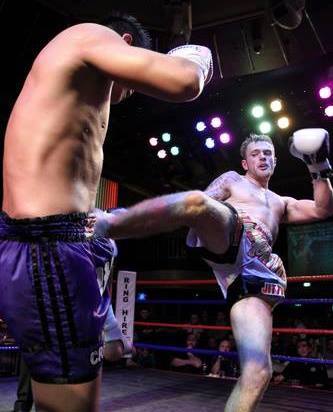Strength and Conditioning for Combat Sport

It shouldn’t still shock me (but it does) when I hear coaches and athletes say that “weight training will slow you down” and/or “lifting weights will bulk you up”.
This isn’t just what I’ve heard from combat sports, this includes a whole host of sporting disciplines, including sprinting, team sport and many other backgrounds that depend on speed and powerful movements.
Boxing, MMA, Muay Thai etc. etc. heavily depend on striking elements (i.e. punch, kick, knee, elbow) which are explosive, powerful movements.
Boxing movements for example, occur in 50-250 milliseconds. In Muay Thai, double kicks (which involve a rapid ground contact time-GCT) and knees have been compared (anecdotally) to sprint running movements, where times of 101 milliseconds GCT have been recorded (1). Now, we know that it takes 600-800 milliseconds to develop peak force so the ability to generate force as quickly as possible is essential in striking movements.
This leads us onto the main focus when trying to improve striking ability – RFD or Rate of Force Development, the ability to accelerate objects, e.g. your fist! We need to increase an athlete’s power!
FORCE X VELOCITY = POWER!
But how can we increase the RFD and in turn increase striking speed/force? Sure, you can increase hand/kick speed with pad work and the INTENT to move quickly. As mentioned is previous posts, you’ve got to train fast to get fast! But I’m sure most are already doing this in the gym.
What else can we do? This is where strength and conditioning can have a real impact on performance. We are NOT looking to implement a high volume, high reps, body-building, single joint training approach here, we need to be smart and look at methods that will complement sport performance.
Max strength has been shown time and time again to have a direct link to peak power output. Strength is a foundation for building power, so why wouldn’t you want to get strong as a combat athlete?!! The key to strength training is utilising compound lifts such as squats, deadlifts, bench and chins, with relatively low reps (up to 6), at an intensity of 85% 1RM and over.
Due to the desire to fight within a particular weight class, strength training has often been viewed as a no-go area for combat athletes due to the perception of building unwanted body mass. The method of training suggested above will not BULK UP an athlete due to the low volumes of training that should be adhered to with combat athletes. There will be structural changes in the body (beneficial for injury prevention) but this will not result in Arnold Schwarzenegger guns!!
Next, we can look to use ballistic exercises such as jump squats with lights loads or medicine ball exercises which will again improve RFD. These external loads (medicine ball, barbell etc.) should be light enough for the individual so that the movement is rapid and always performed with maximal intent.
The Olympic lifts (snatch, clean and jerk) produce some of the highest power outputs of any exercise method, if performed correctly. There are certainly other methods you could employ to get a similar training affect such as trap bar jumps and heavy sled drives etc. Derivatives of the Olympic lifts such as hang snatch or hang cleans are certainly worthwhile using with combat athletes and involve a key movement to generate force known as triple extension, which refers to the synchronised, explosive straightening of the ankle, knee and hip joints. Again, something to consider using in your training programme.
Finally, reactive strength which describes the stretch-shortening cycle (SSC) ability of an athlete is a crucial element in generating force rapidly. Put simply, the ability to drive the foot forcefully into the ground, rebound and transfer the force back up the body to deliver a strike as quickly as possible is crucial for combat athletes. It’s that spring like, reactive strength that can help to deliver devastating strikes. NOTE: ‘true plyometrics’ are advanced exercises and require a high level of technical competency and strength before performing
So just to summarise, we’ve got strength training that not only increases power development, but also provides more robust tissue in an athlete, reducing injury risk. Ballistic, plyometric and Olympic style weightlifting will all greatly improve RFD/power in an athlete, thereby giving you devastating knockout punches, kick, knees and/or elbows.
If you want optimal results from your training, you need to utilise ALL of these elements, strength, power and speed together, in a well planned training programme! Strength and conditioning can be a game changer but you need to train smartly and plan accordingly!
Thanks for reading!
Message below if you have any questions or comments!
